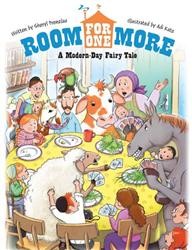When an author and illustrator take on the challenge of reinterpreting a classic, they face an inevitable challenge. In Benjy’s Blanket, Miguel Gouveia and Raquel Catalina offer a new approach to the classic Yiddish folktale and song about a humble garment that eventually disintegrates, but survives in the form of a metaphor about the permanence of storytelling. Although readers will be reminded of both Simms Taback’s Joseph Had a Little Overcoat and My Grandfather’s Coat by Jim Aylesworth and Barbara McClintock, Benjy’s Blanket engages with the idea of transient objects and lasting language in a unique way. Where the earlier classics used rhythmic lines to involve readers, Gouveia constructs a quiet and matter-of-fact narrative of a boy and his grandfather, illustrated by Catalina’s emotionally evocative pictures. The result is an unforgettable picture book about intergenerational bonds.
Benjy is the recipient of a special gift, a “beautiful blanket for his cradle” from his tailor grandfather. Readers first see Benjy as an infant, peacefully sleeping while covered with this comforting item. Soon he grows older, and imaginatively repurposes the blanket as a superhero cape. When his mother rather insensitively suggests throwing the blanket away, Benjy replies that he needs it to fly. Benjy’s mother’s skepticism stands in contrast to Benjy’s faith in his grandfather, whose powers of creativity as a tailor extend to sustaining life itself. In fact, the boy’s relationship with his grandfather is the foundation of his sense of security, almost a magic talisman guiding him through childhood. When Benjy loses the last remnant of the shrinking blanket — a button — Benjy’s mother again disappoints by sensibly asking what Grandad can do with nothing. Benjy’s response echoes the voice of every child who has been given the gift of confidence by an older mentor: “I’m not sure … but Grandad always knows what to do.”
Catalina captures the story’s poignant sense of inevitable decline as well as its uplifting reminder that children will eventually become independent through both assimilating and renewing the values of their elders. The grandfather’s lined face and stooped body depict old age realistically, but his strength as a caretaker is undiminished. Catalina also shows Benjy maturing from a toddler reaching out to hug his grandfather to an older boy energetically playing soccer. In one illustration, the thoughtful grandson watches his grandfather repair the blanket at his sewing machine and tries on the resulting vest in front of the full-length mirror that reflects his growth. Other illustrations are carefully arranged still lifes of the tools of Grandad’s trade: a pattern piece, a flat iron, a piece of chalk guided by the old man’s hand.
A transitional scene of birds flying through the sky on a windy day hints at eventual loss. Grandfather and grandson wave goodbye to one another but they have one more project to realize, this time together. The book moves with great delicacy to the realm of metaphor, as Benjy discovers that, although nothing of his grandfather’s original creation remains, he is now old enough to pick up the thread of his grandfather’s life by writing a story. The concluding pages show a young hand writing on a notepad and an older one resting on a surface surrounded by buttons, thread, and pins. While the original folk song playfully suggests that one can create something from nothing, Benjy’s Blanket replaces that notion with clear evidence of what is left. The grandfather’s legacy of dedication and love are the “good enough material” that the boy will transform into lasting words.
Parents, grandparents, and other caregivers may want to share this highly recommended story as a read aloud.
Emily Schneider writes about literature, feminism, and culture for Tablet, The Forward, The Horn Book, and other publications, and writes about children’s books on her blog. She has a Ph.D. in Romance Languages and Literatures.





